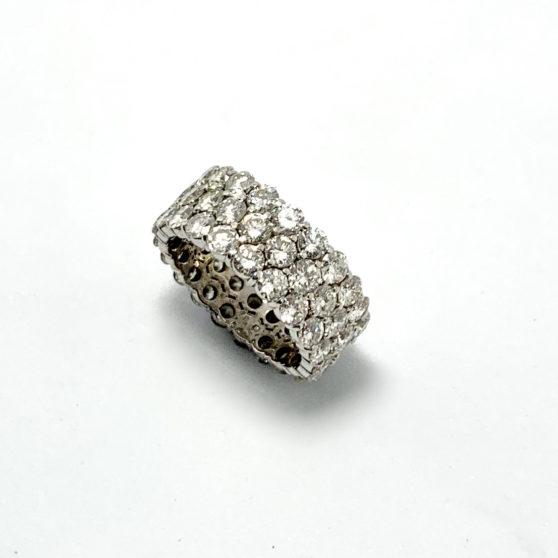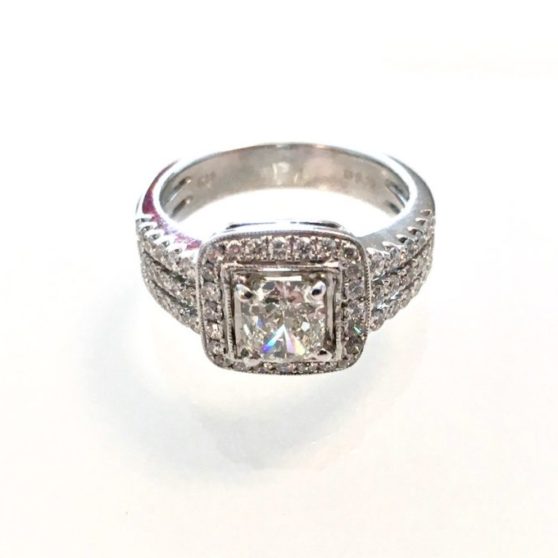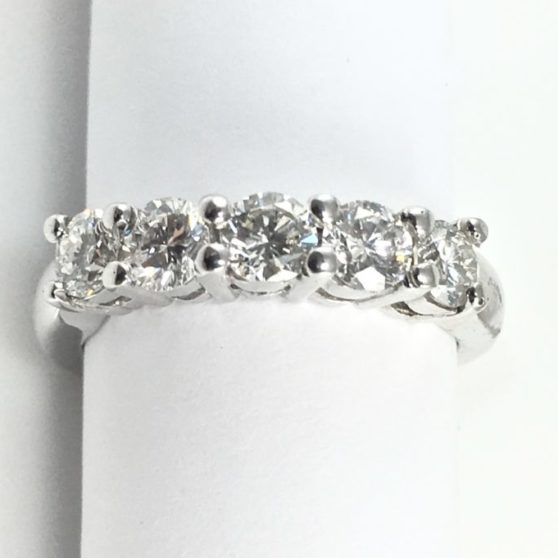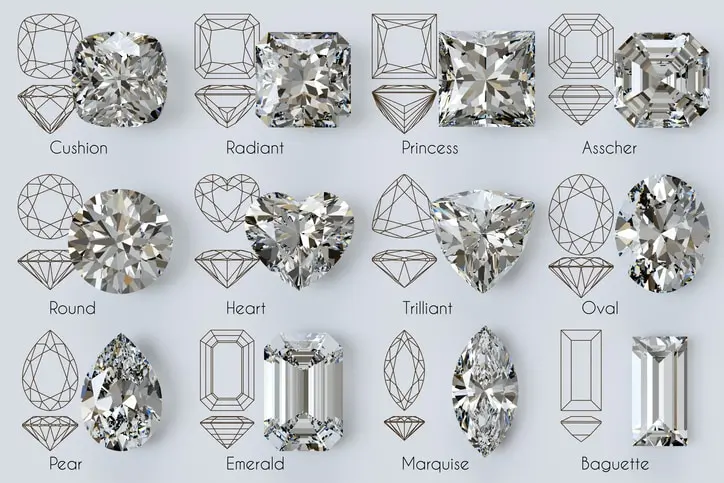ENGAGEMENT RINGS

Being part of hundreds of engagements spanning four decades, we understand that your wedding day is one of the most memorable occasions of your life, and we are dedicated to helping you find the perfect engagement rings to complement your beauty and celebrate your love. Our stunning selection of engagement jewelry, necklaces, earrings, and more is designed to add elegance and sparkle to your big day. Whether you’re a bride, groom, member of the wedding party, or a guest, we have something for everyone to make your wedding day unforgettable.




-
 Eternity Band with Six Carats of Brilliant Diamonds$8,500.00
Eternity Band with Six Carats of Brilliant Diamonds$8,500.00 -
 1.00 Carat Princess Cut Diamond 18K Halo Ring$5,000.00
1.00 Carat Princess Cut Diamond 18K Halo Ring$5,000.00 -
 Diamond Platinum Wedding Band$3,000.00
Diamond Platinum Wedding Band$3,000.00
Jewelry

Table: The flat top surface of the diamond that light enters through.
Table Size: The table’s width is expressed as a percentage of the overall diameter.
Star Length: The length of the star facet pattern visible when viewing from above.
Girdle: The outer edge or belt-like circumference that separates the crown from the pavilion.
Girdle Thickness: The measurement representing how thin or thick the girdle is.
Crown Height: The distance from the table to the girdle determines how tall or short it appears.
Crown Angle: The angle at which crown facets are positioned in relation to the table, affecting light reflection and refraction.
Pavilion Depth: The distance from the bottom point (culet) to the girdle, impacting brilliance and fire.
Pavilion Angle: The angle at which pavilion facets are positioned in relation to each other, influencing light reflection and refraction within a diamond.
Total Depth: The overall height from culet to table is expressed as a percentage of diamond diameter; it affects brilliance and fire.
Lower Girdle/Half Facet Length: Refers to individual lower girdle or half-facet lengths around its circumference; affects symmetry and light performance.
Culet: A small facet at the bottom tip of a diamond’s pavilion; it can be pointed or slightly rounded.
*The image and more information from the GIA can be seen here.
CARAT WEIGHT
The Carat Weight measures a diamond’s weight, not its size.
- Carat: One carat is equal to 200 milligrams, or 0.2 grams.
- Points: Diamonds are often measured in points, with one carat equal to 100 points. For example, a diamond weighing 0.75 carats may be called a “75-point diamond.”
- Total Carat Weight (TCW): When a piece of jewelry contains multiple diamonds, the total carat weight refers to the combined carat weight of all the diamonds in the piece.
Carat Weight Affects The Diamond’s Size
While carat weight measures a diamond’s weight, it impacts its size. Generally, as the carat weight of a diamond increases, so does its size. However, it’s important to note that carat weight is not the only factor determining a diamond’s size. The diamond’s cut, shape, and proportions also significantly affect how large the diamond appears.
Diamond Pricing
Carat weight has a significant impact on the price of a diamond. As the carat weight increases, the price tends to increase exponentially, especially at the higher end of the carat scale. Larger diamonds are rarer and more desirable, raising their price.
Balancing Carat Weight with the 4 C;s
When choosing a diamond, it’s essential to consider carat weight with other factors, known as the 4Cs: cut, color, and clarity. While carat weight is important, it’s equally crucial to prioritize the overall quality of the diamond. A smaller diamond with excellent cut, color, and clarity may appear more brilliant and beautiful than a larger diamond with lesser quality in these areas.
COLOR GRADE
Color is one of the most important factors when choosing a diamond. The Gemological Institute of America (GIA) grades diamond color on a scale from D (colorless) to Z (light yellow or brown). The less color a diamond has, the more valuable it is.
Here are some key points to consider when evaluating diamond color:
- Understanding the GIA Color Scale: The GIA color scale starts at D for colorless diamonds and progresses to Z for diamonds with noticeable color. Colorless diamonds are rarer and more valuable, while diamonds with a noticeable yellow or brown tint are less valuable.
- Choosing the Right Color Grade: The ideal diamond color grade depends on personal preference and budget. Colorless diamonds (D-F) and near-colorless diamonds (G-J) are popular for engagement rings and other fine jewelry. However, diamonds in the near-colorless range (G-H) can offer excellent value while appearing white to the naked eye.
- Considering Metal Type: The color of the metal in the setting can affect how the diamond’s color appears. For example, a colorless diamond may look more vibrant in a white gold or platinum setting, while a warmer-toned diamond might complement a yellow gold setting.
- Balancing Color and Budget: While colorless diamonds are highly sought after, they also have a higher price tag. Consider your budget and prioritize the factors that are most important to you, whether it’s size, cut, clarity, or color.
- Viewing Diamonds in Different Lighting: Natural daylight and LED lighting can help you assess the diamond’s true color, as some lighting can mask or enhance a diamond’s hue.
By understanding diamond color and how it impacts a diamond’s appearance and value, you can make an informed decision when selecting the perfect diamond for your jewelry piece.
CLARITY GRADE
When it comes to evaluating a diamond’s quality, clarity is a crucial factor. Diamond clarity refers to the presence of internal and external flaws, known as inclusions and blemishes. These imperfections can affect the diamond’s appearance and, consequently, its value. Understanding diamond clarity is essential for anyone purchasing a diamond, as it directly impacts the stone’s brilliance and overall beauty.
The Gemological Institute of America (GIA) has established a widely accepted grading scale for diamond clarity, ranging from “Flawless” (no inclusions or blemishes visible under 10x magnification) to “Included” (inclusions and blemishes are visible to the naked eye). In between these two extremes, several grades consider the imperfections’ size, location, nature, and quantity.
Diamond clarity is assessed using a combination of magnification and observation under controlled lighting conditions. Gemologists examine the diamond to identify inclusions and blemishes and determine their impact on its overall appearance. The location of the imperfections within the diamond can also influence its clarity grade. Inclusions or blemishes near the diamond’s center may be more noticeable and impact its brilliance.
It’s important to note that not all imperfections are visible to the naked eye. Many diamonds with slight inclusions or blemishes are considered “eye-clean,” meaning these imperfections are not visible without magnification. This allows buyers to choose diamonds with slightly lower clarity grades that still appear flawless to the naked eye, allowing for cost savings without sacrificing visual appeal.
Diamond clarity directly affects a diamond’s value, with flawless diamonds commanding the highest prices due to their rarity and exceptional beauty. However, for most consumers, a diamond with minor inclusions not visible to the naked eye offers an excellent balance of quality and value.
In conclusion, understanding diamond clarity is essential for anyone considering a diamond. By familiarizing yourself with the GIA clarity scale and the impact of inclusions and blemishes on a diamond’s appearance, you can make an informed decision and select a diamond that meets your preferences and budget while still radiating exquisite beauty.
CUT

- Round Cut:
The round cut is the most popular and classic of all diamond cuts. Known for its 58 facets, the round-cut diamond is designed to maximize brilliance and sparkle. This timeless cut is versatile and suits various jewelry styles, making it a perennial favorite for engagement rings. - Princess Cut:
The princess cut is a square or rectangular-shaped diamond with pointed corners. This cut is known for its contemporary yet elegant appearance. With its clean lines and brilliant sparkle, the princess cut is a popular choice for engagement rings and other jewelry pieces. - Emerald Cut:
The emerald cut is characterized by its rectangular shape and step-cut facets. This cut emphasizes the diamond’s clarity and luster, making it an excellent choice for those who appreciate sophistication and refinement. The emerald cut is often featured in vintage-inspired and Art Deco jewelry designs. - Asscher Cut:
Like the emerald cut, the Asscher cut is square-shaped with step-cut facets. However, the Asscher cut is more octagonal with more significant step facets, giving it a unique, mesmerizing appeal. This cut is ideal for those seeking a distinctive, vintage-inspired look. - Oval Cut:
The oval cut diamond features an elongated, oval shape that creates the illusion of a larger size. This cut is favored for its flattering appearance on the finger and its ability to exhibit brilliance and fire, similar to the round cut. The oval cut is a stylish, unique, yet timeless diamond shape. - Marquise Cut:
The marquise cut diamond is characterized by its elongated, boat-shaped silhouette with pointed ends. This cut is designed to maximize the diamond’s carat weight, giving the illusion of a larger size. The marquise cut is an excellent choice for those who appreciate a bold, eye-catching look. - Pear Cut:
The pear cut, or teardrop cut, combines round and marquise shapes. It features a rounded end that tapers to a point. This cut offers a graceful, elegant appearance with a touch of whimsy, making it an ideal choice for those who seek a romantic and unique diamond shape. - Heart Cut:
As the name suggests, the heart-cut diamond symbolizes love and romance. This cut features a distinctive heart shape with a cleft at the top, making it a meaningful choice for engagement rings and romantic jewelry.

STONE CERTIFICATION
You want a high-quality and authentic gemstone when purchasing a diamond or other precious stone. This is where diamond certification comes into play. Diamond certification, a diamond grading report, is issued by an independent gemological laboratory that evaluates and identifies a diamond’s unique characteristics. This certification assures the diamond’s quality, authenticity, and value.
Diamond certification involves thoroughly assessing the diamond’s 4Cs: cut, color, clarity, and carat weight. These factors determine the overall quality and value of the diamond. The certification also includes additional information such as measurements, fluorescence, symmetry, and any potential enhancements the diamond may have undergone.
One of the most well-known and respected gemological laboratories is the Gemological Institute of America (GIA). Diamonds accompanied by a GIA certificate are highly regarded in the industry due to the institute’s strict grading standards and reputation for unbiased assessments.
Other reputable gemological laboratories include the American Gem Society (AGS), the International Gemological Institute (IGI), and the Hoge Raad voor Diamant (HRD) in Antwerp, Belgium. Each follows standardized procedures to evaluate and grade diamonds accurately.
Diamond certification serves as a valuable tool for both buyers and sellers. For buyers, a certified diamond provides confidence in the quality and authenticity of the stone, ensuring that they are getting what they pay for. For sellers, having a diamond certified by a reputable laboratory adds credibility to the product and can facilitate a smoother transaction.
It’s important to note that not all diamond certificates are created equal. Some less reputable labs may provide inflated grades or inaccurate assessments, which can mislead buyers. Therefore, it’s crucial to verify the credibility of the issuing laboratory before placing trust in the certification.
In conclusion, diamond certification plays a vital role in the diamond industry by objectively evaluating a diamond’s quality and characteristics. Whether buying a diamond for an engagement ring, a special occasion, or an investment, always insist on a diamond with a reputable certification to ensure its quality and value.
DIAMOND HISTORY
The history of diamonds is a mesmerizing journey that spans billions of years and encompasses diverse cultures and civilizations. Formed deep within the Earth’s mantle under intense heat and pressure, diamonds were first unearthed in India over 4,000 years ago. The term “diamond” originates from the Greek word “adamas,” signifying invincibility, reflecting the stone’s extraordinary hardness.
Throughout ancient times, diamonds were treasured for their resilience and radiance. They often served as talismans and amulets for protection and as symbols of strength, courage, and invincibility. The earliest documented history of diamond mining and trade dates back to the 4th century BC in India, where diamonds were discovered along the rivers and streams of the region.
India remained the principal source of diamonds until the 18th century, when diamond deposits were found in Brazil. This discovery revolutionized the global diamond trade, with Brazil becoming the world’s leading diamond producer for nearly 150 years. In the late 19th century, diamond deposits were uncovered in South Africa, sparking a diamond rush and the establishment of Kimberley’s renowned diamond mining town.
The 19th century also witnessed the emergence of diamond engagement rings, popularized by the British monarchy. In the mid-20th century, De Beers’ iconic marketing campaign, “A Diamond is Forever,” further solidified the diamond’s status as the ultimate symbol of love and commitment.
Today, diamonds are mined and traded worldwide, with major producers including Russia, Botswana, Canada, and Australia. The diamond industry has made remarkable strides in technology, enabling more efficient extraction and processing while upholding ethical and sustainable practices.
Throughout history, diamonds have enthralled the human imagination and have been revered for their beauty, rarity, and enduring symbolism. From ancient civilizations to modern societies, the allure of diamonds continues to captivate people worldwide, promising a future as rich and captivating as its storied past.
MOUNTING STYLES
The mounting style of an engagement ring refers to how the diamond or gemstone is set into the ring. Prong settings are the most common, featuring four or six prongs holding the stone. Bezel settings encircle the stone with metal, while channel settings feature stones set into a channel in the band. Tension settings hold the stone in place with pressure from the band.
Solitaire rings feature a single diamond or gemstone in a simple setting.
Halo rings have a center stone surrounded by a halo of smaller diamonds or gemstones.
Three-stone rings feature three stones, with the center stone typically more significant than the other two.
Designs from previous eras inspire vintage rings.
Pave rings feature small diamonds or gemstones set closely together to create a sparkling surface.
BUDGET
An engagement ring’s value is determined by several factors, including the quality of the diamond or gemstone, the metal used to make the band, and the overall design and craftsmanship of the ring.
Setting a budget is an essential first step when purchasing an engagement ring. A well-thought-out budget can help you find the perfect ring without straining your finances. Here are some key factors when budgeting for an engagement ring purchase.
Take Charge of Your Financial Situation: Before setting a budget, it’s crucial to take a comprehensive look at your financial situation. This includes your current income, savings, and any other financial commitments. By doing so, you’re taking a responsible step towards ensuring you can comfortably afford the ring without going into debt.
The 3-Month Rule: While it’s a traditional guideline that an engagement ring should cost around three months’ salary, it’s important to remember that this rule is not rigid. It’s a flexible tool that can be adjusted to suit your circumstances, empowering you to make a decision that aligns with your financial goals.
Research Ring Prices: Researching the current prices of engagement rings will give you a realistic idea of what to expect within your budget. Remember that the cost of a ring can vary widely based on factors such as the type of metal, the quality of the diamond or gemstone, and the intricacy of the design.
Focus on Your Priorities: It’s essential to consider what aspects of the ring are most important to you and your partner. Is it the size and quality of the stone, the type of metal, or the overall design? By understanding and prioritizing these aspects, you can allocate your budget effectively and make a choice that truly reflects your preferences.
Factor in Future Expenses: While it’s essential to find a ring that fits your current budget, also consider any future expenses that may be on the horizon, such as the wedding itself, a honeymoon, or purchasing a home. Striking a balance between the present and the future is vital.
Be Open About Your Budget: When shopping for an engagement ring, communicate your budget clearly with your trusted jeweler. A reputable jeweler can guide you toward options that meet your budget while ensuring quality and beauty.
Remember, the sentiment behind the ring is what truly matters. The most important consideration is finding a ring that reflects your love and commitment within a budget that works for you. You can find the perfect engagement ring without overspending with careful planning and thoughtful consideration.
PROCEDURE
1. Initial Meeting: You and I will meet by phone or in-person to discuss your wish list. We will discuss the four C’s of diamonds (color, cut (shape), clarity, and cost), budget, timeline, and any other thoughts or questions that may arise.
2. Mounting Options: We will discuss mounting styles and the three avenues for mountings: estate, newly fabricated, or custom-designed.
3. Research: I will then start searching for the perfect stone. Working within your budget, I will search my inventory and connections to gather the best choices for my client. Your task is to learn your fiance’s ring size; this can be difficult to do in secret, so start now.
3. Gemstone Evaluation: I provide my client pictures of the stones and copies of gem reports (GIA https://www.gia.edu, AGL https://www.aglgemlab.com) and stone pricing. We study and compare the different choices and pick the stone.
4. Ring Mounting: At this point, knowing the needed ring size is necessary. Once a stone is selected, we will choose an existing mounting or design a custom mounting, deciding on the metal type: platinum, white or yellow gold, 14k or 18k.
6. Ring Design: If one of our suppliers has the mounting in inventory, we may bypass step 6 and proceed to step seven. I will submit your final choices to our design team, who will draw up the design.
7. Ring Construction: Our design team will build your ring upon approval. Once it is completed to KP Gems standards, I will call you to arrange pick-up, delivery, or shipment.
Men’s Wedding Bands
When choosing a wedding band, men have more options than ever before. From classic gold bands to modern titanium rings, there’s a style to suit every taste and personality. Here’s a guide to the different styles, fits, and materials for men’s wedding bands.
Styles:
Men’s wedding bands come in various styles to match individual preferences and lifestyles. Classic bands are simple and timeless, usually made of gold or platinum. For a more distinctive look, men can opt for brushed or hammered finishes, textured surfaces, or bands with inlaid gemstones or diamonds. Modern designs include sleek black titanium or tungsten rings, which are durable and scratch-resistant.
Fit and Feel:
Comfort is key when choosing a wedding band. Traditional fit bands have a rounded interior for a comfortable feel, while flat fit bands have a more contemporary look. Comfort-fit bands, with a slightly rounded interior, are designed for all-day wear and are especially popular for men not used to wearing jewelry.
Precious Metals:
Gold, platinum, and silver are the most popular choices for men’s wedding bands. Gold comes in various colors, including classic yellow gold, modern white gold, and trendy rose gold. Platinum is a durable and hypoallergenic metal with a naturally white luster. Silver is an affordable option but may tarnish over time.
Choosing the Right Band:
When selecting a men’s wedding band, one must consider personal style, everyday activities, and budget. Trying on different styles and materials can help determine the best fit and feel. Whether opting for a classic gold band or a contemporary titanium ring, the perfect men’s wedding band symbolizes commitment and personal expression.
Frequently Asked Questions
Q: What are the current trends and popular designs for engagement rings?
A: The current trends for engagement rings include vintage-inspired designs, unique geometric shapes, and nature-inspired elements such as floral motifs and leaf designs.
Q: How do I choose a suitable stone for an engagement ring?
A: When selecting a stone for an engagement ring, consider the 4Cs (cut, color, clarity, and carat weight) for diamonds or the color, clarity, and size for alternative stones such as sapphires or moissanite.
Q: What are the options for metal selection for engagement rings?
A: Popular engagement ring metals include platinum, white gold, yellow gold, rose gold, and alternative metals such as palladium or titanium.
Q: What should I consider when selecting the mounting for the engagement ring?
A: When choosing the mounting for an engagement ring, consider the durability, style, and setting type that best complements the selected stone.
Q: How can I accurately measure the ring size?
A: To measure for ring size, use a ring sizer tool, visit a jeweler for professional sizing, or discreetly borrow one of your partner’s rings for comparison.
Q: What is the value of diamond certification when purchasing an engagement ring?
A: Diamond certification from reputable gemological laboratories such as GIA or AGS assures a diamond’s quality and authenticity, offering peace of mind for the purchase.
Q: How do I determine an appropriate budget for an engagement ring?
A: Consider your financial situation and prioritize what aspects of the ring are most important to you. Establishing a budget that feels comfortable and realistic for your circumstances is essential.
Q: What is the typical timeline for designing and obtaining an engagement ring?
A: The timeline for obtaining an engagement ring can vary based on custom design, stone selection, and necessary resizing. It’s advisable to allow several weeks to ensure the ring is ready for your planned proposal.

